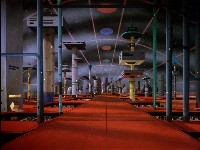SFX
by Martin Willey
Mattes were first used by the Lumière brothers from 1895. One portion of the camera lens is blocked (so the film is unexposed). The film is rewound, then the other side is blocked. The two different sides of the picture would appear to have been filmed together (see also multiple exposures).
Norman Dawn developed the technique in 1907 by inventing the glass matte. The camera films through a glass sheet, parts of which are painted. On film, the painted sections cover the background; the camera operator can align the picture so the illusion is perfect. He also developed a version of the traditional matte, using glass with black paint. From the 1920s, film increasingly used the bipack method, in which the camera films with two film reels together, one unexposed which captured both the action and the image from the other film reel, or a version of the stationary matte with black card mattes over the camera lens (rather than a large piece of glass).
The primary role of special effects for most films from the 1920s to the 1950s was matte painting, to replace and extend buildings and landscapes, using either bipack or mattes. Blue screen compositing reduced the need for matte paintings, and computer graphics now create the set extensions. A variation was the Schufftan process, which used an angled mirror (see mirror effects) and could add (a reflection of) a model or painting to the side of the camera.
Space: 1999 employed Ray Caple as a matte painter, who, like Brian Johnson and Derek Meddings, started his career working for Les Bowie. Most of the shots are traditional painted mattes, with no actual matte sections. Two shots are glass mattes, one with a photographic Eagle, the other with a matte painting. These were probably shot in-camera, with the camera filming through the painting and glass (rather than creating a matte, rewinding the film, and re-exposing it to film the painting).
Space nebula and planets were also paintings.

Another Time, Another Place, the crew leave the "full sized" Eagle (the shot is reused in The Testament Of Arkadia). The Eagle is a foreground cut-out mounted on glass; the rear leg is a full sized photo cut-out of the front leg, mounted behind the actors. It was filmed at Bray Studios, using stand-ins, on Monday 8th July 1974, during the filming of the episode Alpha Child.



The 44 inch model was photographed - this was the original photo (see here). A large photo cut-out was created, mounted on glass, with only the front leg and command module. Just the front leg from this photograph was turned into a large full-sized flat, positioned behind the actors.
The following video by Roberto Baldassari demonstrates how the effect was created.

Another Time, Another Place split screen, with Barbara Bain talking to herself. This was probably a glass matte, filmed in-camera, rather than an optical compositing shot. One side of the camera's view is blocked by black glass, while Barbara plays against her stand-in. The film is rewound, and the black glass moved to the other side, and Barbara appears on the other side of the set.

Another split screen, this time with two Koenigs, from Seed of Destruction. The camera doesn't move, so the join line between the left and right side of the screen is invisible.

Missing Link. This is a painting, with flashing lights behind the glass to animate it. The Eagle (and in another shot, the Moon) are double-exposures, added to the sky. Unused footage

The Last Enemy, another painting.



Mission Of The Darians, three matte paintings, one a proper glass shot with actors seen through the glass.

For The Last Sunset, another Eagle matte shot was planned, similar to the Another Time, Another Place shot. It would have looked something like this. Storyboard details
Copyright Martin Willey